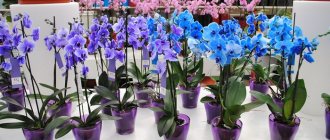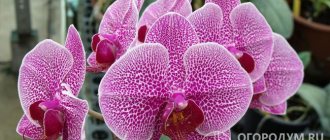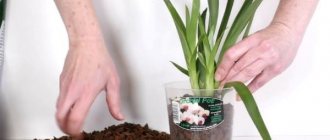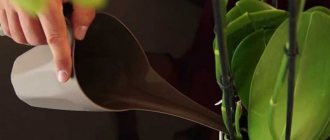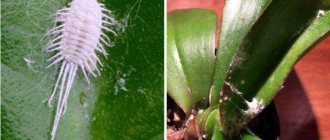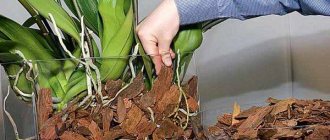What is glucose used for?
One of the important factors for the normal growth of an orchid is an active respiratory process. For its uninterrupted operation, the plant consumes a large amount of resources, which must be replenished constantly. Energy is supplied by glucose .
In close union with other nutritional compounds, it forms complex organic substances necessary for the formation of plant tissues.
Glucose is a complex organic substance that reacts with other compounds with the participation of carbon dioxide.
Glucose is a direct participant in the formation and development of floral organs . The orchid spends the most nutrients on these processes. If there are not enough of them, the flower stalks grow weak, the buds become small, and the flowers become pale. Glucose is not just a source of nutrients, it ensures the delivery and maximum absorption of useful elements.
In terms of its composition, glucose is a complex organic substance that reacts with other compounds in the presence of a sufficient amount of carbon dioxide CO2. If there is not enough of it, glucose is at best useless. The worst option is when it fills the substrate with dead weight and becomes a favorable breeding ground for pathogenic microorganisms that cause diseases of orchids.
Carbon dioxide is one of the waste products of plants. If the respiratory process is normal, then CO2 will be enough to convert glucose. Thus, the circle is closed.
“Non-standard fertilizers for orchids”, author – V. Kolyvanova, “World of Orchids” magazine, No. 4, 2008.
In order for sweet nutrition to be beneficial and not serve as a source of disease, it is better to use it together with EO preparations. They contain effective microorganisms that convert the substrate into nutrients. At the same time, their active growth suppresses the development of pathogenic flora that causes orchid diseases.
Among the popular EM products, they are often used in the care of orchids.
"Baikal EM - 1". In its presence, glucose “works” with maximum efficiency.
What substances are needed
For the normal development of an orchid and its long, abundant flowering, many minerals are needed. Next, we will consider those substances whose presence in feeding is absolutely necessary.
Nitrogen
This element is an essential component of all protein and other organic compounds in plant tissues. The main function of nitrogen is to launch the intensive process of photosynthesis, which affects all life processes, primarily the formation of lush green mass.
If the orchid does not have enough nitrogen, it will react to this fact by shredding, turning pale leaves, losing a fair amount of decorativeness, drooping, weakening the stem, and stopping development.
Potassium
This mineral is responsible for carbon metabolism in plant tissues, and in general for the health of the flower. Potassium directly affects the formation of flower buds, so the use of the mineral is extremely important for lush flowering. Potassium is also necessary for cellular water exchange. This mineral increases the orchid’s immunity and resistance to various diseases and misfortunes.
If an orchid experiences a lack of potassium, this will manifest itself in the form of too small buds and a small number of them. In addition, the duration of flowering will become significantly shorter. Due to the lack of potassium, by the way, nitrogen cannot be fully absorbed.
Phosphorus
The orchid needs the mineral for the correct and active development of roots, as well as for the complete transmission of all important varietal genetic characteristics to the offspring. Phosphorus is also indispensable in the processes of flowering and plant reproduction. If an orchid is critically short of phosphorus, it may even die; in milder cases, it weakens and withers.
Magnesium and boron
Microelements necessary for normal energy metabolism. With their shortage, the growing season noticeably slows down, which greatly affects the development and flowering of the orchid. It is likely that the buds will dry out, flowering will stop completely, and even the growing points will die off.
Sulfur and iron
A lack of these minerals is likely to lead to yellowing of the foliage - so-called chlorosis. Orchid leaves affected by chlorosis become much less decorative, take on a sickly appearance, and wither. In severe cases, the foliage dries out and dies.
In addition to the minerals already listed, in smaller quantities, but nevertheless, the following substances are also needed:
- zinc;
- manganese;
- chlorine.
Make sure that they are present in the complex fertilizer.
Where to buy
Buying a sweet remedy is not a problem. It is sold in every pharmacy in tablets.
Glucose tablets are sold in pharmacies.
In addition, it is produced in liquid form in bottles or ampoules.
Glucose is sold not only in pharmacies. It is available in grocery stores and supermarkets, in confectionery departments. There it can be purchased under the names:
- “Confectionery glucose” in the form of a snow-white fine-crystalline powder,
- "Glucose syrup" looks like a viscous transparent liquid,
- “Glucose molasses” is a thick amber-colored mass.
Each species is quite suitable for feeding orchids.
Advice from experienced flower growers
There are certain rules that should be followed:
- feed flowers only when they are not in the dormant stage;
- a month should pass after transplantation and only then begin watering with nutrient solutions;
- if the orchid is weakened by disease or parasites, then it should not be fertilized.
IMPORTANT! You need to listen to these small rules to make the flower feel comfortable.
How to prepare glucose correctly
The easiest way is to make fertilizer from tablets. The pharmacy sells tablets
0.5 g.
For the nutrient solution you will need:
- Glucose tablets – 1 pc.,
- Water – 1 l.
The tablet should dissolve completely. To do this, it is better to take warm water +300 – +380.
When the liquid becomes clear, it can be used for feeding.
Instead of tablets, you can use liquid glucose in ampoules or vials.
The amount of active substance depends on the percentage of glucose in the pharmaceutical solution.
| Drug concentration | Dosage per 1 liter of water |
| 40% | 1 ml |
| 5% | 8 – 10 ml |
To prepare a nutrient solution from glucose in ampoules of 40%, 1 piece is enough. for 1 liter of water.
Tip #1 . Liquid glucose from the bottle can be measured using a medical syringe.
If you can’t buy glucose, it doesn’t matter. There is always a substitute for it in any home.
Reviews
Valeria, Saratov. “It’s clear that everyone is trying to find the best for both themselves and their plants. And some, being in search, resort to such exotic things as yeast as a supplement. I don’t know about the effectiveness - I haven’t tried it, but as for me, this is wildness given the current level of technical progress. I heard one woman place moistened pieces of bread under a peony bush. So then for several years I tried to get rid of the fungus that had grown there.”
Natalya, Voronezh. “My grandfather told me about this method of feeding plants. At the dacha he fertilized tomatoes, cucumbers and other vegetables with yeast. I also water my flowers with diluted yeast. They really like it. But this only applies to those plants that grow in the ground. I don’t feed orchids this way, because they grow in the bark and there’s no point in it. I fertilize orchids with regular orchid fertilizers, using the dipping method.”
Anastasia, Kerch. “I feed homemade flowers with yeast, since I always have it on hand. I don’t use other fertilizers (except organic), as I try to use only natural ingredients. In principle, I'm happy with everything. I conducted experiments, compared how plants behaved with and without such feeding, and there was a difference, so I have no doubt about my actions.”
Features of application
Sugar has long been used by flower growers to feed houseplants. Its undeniable advantage is that it is always at hand. But before you feed your orchid with sweet syrup, you need to remember some nuances.
Once in the soil, sugar supplies the plants with glucose, but fructose also appears with it. This substance is completely useless for the orchid, but it is food for pathogenic microorganisms. That's why you shouldn't get carried away with sugar. That is, it must be used in strictly dosed quantities and not too often .
The plant uses the most nutrients during active growth and flowering. With good care, orchids can bloom twice, or even three times a year. That's when they need to restore resources in large quantities. But, even then, frequent application of fertilizer should not exceed once every four weeks.
For feeding, prepare a solution in the following proportions:
| Granulated sugar | 1 tablespoon (not heaped) |
| Water (warm +400) | 500 ml (0.5 l) |
The resulting solution is poured over the orchid substrate.
Important! Fertilizer is applied so that it does not fall on the axils of the leaves. Stagnation of liquid in the recesses can cause rotting of plant tissue.
Some gardeners advise feeding the orchid with dry granulated sugar. It is poured onto the surface of the substrate in a thin layer. This can be done only after the soil mixture is abundantly moistened. It is best to use bottom watering, or as it is commonly called - bathing. Then, the substrate in the flower pot is wetted completely and evenly.
To fertilize an orchid after watering:
- Take 1 - 2 teaspoons of sugar, depending on the size of the pot.
- The grains are evenly scattered over the surface of the substrate.
- Sprinkle generously with water until the crystals dissolve.
Organic fertilizers
How to feed geranium - means for abundant flowering and growth
How to feed an orchid at home with organic matter so that it grows well, blooms profusely, and also holds well in a pot with a light substrate?
Preparing yeast feed
Rotted manure and wood ash are considered the best fertilizers.
Manure
Rotted horse manure is considered the best for feeding orchids. It must be dissolved in water (1 kg per 10 liters of water) and watered the flower during the period of active leaf growth.
Ash
The ash obtained after burning wood is diluted in water (200 grams per 1 liter of water) and used for watering orchids. This product will compensate for the lack of phosphorus, potassium, calcium and other nutritional components in the soil.
The process of feeding an orchid in a transparent flowerpot
This fertilizer can prevent damaged areas on the plant from rotting.
Foliar feeding of orchids
In addition to traditional watering, you can treat orchid leaves with a solution of glucose or sugar.
The procedure is simple, but it must be done correctly:
- Prepare a solution - glucose - 1 tablet per 1 liter of water (or 1 teaspoon of sugar per 1 liter of water).
- Clean the orchid leaves from dust with a soft, damp cloth and rinse under running warm water. After bathing, the water that has accumulated in the axils of the leaves must be removed using cotton pads.
- And only after this, wipe the leaf plates with glucose solution . This is done with the same cotton pads or a soft cloth dipped in sweet syrup.
- When wiping, you need to make sure that the liquid does not flow into the sinuses. If this happens, then the excess moisture needs to be blotted off.
Before wiping the leaves with glucose, they need to be cleaned of dust and drops of water.
This procedure is carried out not only for planned foliar feeding, but also for resuscitation of orchids damaged by diseases or pests.
Methods of application
The orchid can be fed either by the traditional root method or by foliar feeding. Below we will look at both methods in more detail.
Root feeding
This method of application is traditional and cannot be done without it. In this case, fertilizing fertilizes the roots of the plant directly.
Before applying, it is important to water the soil so that the roots do not get burned. All dry fertilizers are diluted in room temperature water according to the instructions. Feeding is carried out using the submersible method, just like regular watering of an orchid. To fully nourish the roots, a 20-minute immersion is enough. Simultaneously with immersion, you need to scoop liquid fertilizer from the container and water the soil from above. After the procedure, the pot must be placed on a tray and allowed to drain excess liquid.
Foliar
Also a common method of fertilizing, but used less frequently than root fertilization. More often, foliar feeding is used when it is impossible to carry out root feeding: for example, when the roots of the plant are sick or there is chlorosis of the foliage.
This application method should be used with caution and by preparing a weaker working solution. Spraying is carried out from a spray bottle: it is necessary that the liquid gets on the foliage, and not on the inflorescences. It is recommended to spray the orchid in the morning, when there is still no bright sun that can leave burns on the leaves of the plant.
Use against diseases and pests
I plan to use glucose and or sugar to resuscitate a sick orchid, remember that this is not a medicine, but a supportive and restorative agent. Lotions are made from it. The procedure is similar to wiping the leaves. A cloth soaked in a glucose (or sugar) solution is applied to the leaf plates, wrapping them. Press lightly and leave for several minutes.
Lotions are required for leaves affected by diseases and pests. But, it is advisable to wipe and wrap all the plates so that the infection does not spread to healthy tissue. After such treatment, a thin nutrient film is formed, which prevents the spread of pathogens and repels pests.
After this procedure, it is better to spray no earlier than a month later.
What are the results of improper watering?
Improper watering can lead to the death of the orchid. Although this plant is moisture-loving, it is still better to underwater than overwater. Otherwise, the roots will simply rot. After all, in nature, orchids grow on stones and tree branches.
Do not allow water to stagnate in the tray and in the orchid pot. This will lead to rotting of the roots and death of the plant. When there is an excess of moisture, swelling appears on the leaves , which cannot be treated; they only need to be removed.
We must not forget that an orchid is a capricious plant, and proper watering is one of the important conditions for its health. If you follow simple rules, the orchid will delight you with its flowering for a long time.
Category: “Question and answer”
Question No. 1 . If the leaves of an orchid have turned yellow, can you feed it with sugar?
Answer.
First you need to establish the reason why the yellowing occurred.
- Perhaps the bottom leaf has turned yellow from age and needs to be removed so that it does not take away nutrition from young organs.
- Sometimes leaves change color due to lack of nutrients. And glucose alone will not cope with the problem. Here you will need a complex set of elements.
Glucose lotions will help when the leaves can absorb moisture and nutrition. In damaged integumentary tissues, this ability is sharply reduced. In this case, glucose will not help. Treatment will have to be carried out using fungicides against diseases or insecticides and acaricides against pests.
Useful video
From the video you will learn how to water an orchid to prevent rotting:
If you find an error, please select a piece of text and press Ctrl+Enter.
“Grows by leaps and bounds” - this old saying is also true for plants. However, not every plant, or rather the substrate in which it lives, is suitable for feeding with yeast.
So, is it possible to water an orchid with yeast and how to do it correctly - read this article. Because mistakes, as a result of misunderstanding of the material, can simply reduce all your efforts to nothing.
When is it time to fertilize?
The plant itself will tell you what it is missing. For example, faded leaves with noticeable redness on the reverse side, twisted new shoots indicate a lack of phosphorus (P). Nitrogen (N) deficiency results in small, limp leaves with yellowish or light green marbled spots.
Weak stiffness of the lower leaves and their rapid death, the presence of a yellow or white rim on dark green leaves indicate a lack of potassium (K). Love your phalaenopsis and it will give you beautiful blooms.

